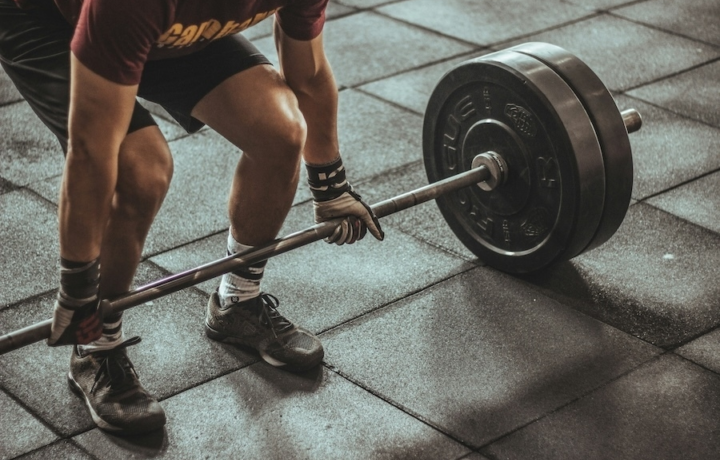Exercise
Dumbbell Lying Leg Curl

Dumbbell Lying Leg Curl
How to Perform
- Position yourself face down on a bench or exercise mat with your legs extended straight behind you and your hips resting on the bench.
- Place a dumbbell securely between your feet, gripping it firmly by squeezing your feet together around the dumbbell handle.
- Keep your upper body stabilized by placing your hands on the floor or gripping the sides of the bench, maintaining a neutral spine position throughout the movement.
- Engage your core muscles and slightly tuck your pelvis to protect your lower back from excessive arching.
- Inhale, then as you exhale, bend your knees and curl the dumbbell toward your glutes by contracting your hamstrings.
- Continue the curling motion until your knees reach approximately a 90-degree angle, or until you feel a complete contraction in your hamstrings.
- Hold the contracted position briefly while maintaining tension in your hamstrings, keeping your feet flexed to secure the dumbbell.
- Inhale as you slowly lower the dumbbell back to the starting position by extending your legs in a controlled manner, maintaining tension in your hamstrings throughout the entire range of motion.
Important information
- Make sure your hips remain in contact with the bench throughout the entire movement to properly isolate the hamstrings.
- Keep your ankles flexed (toes pointed toward your shins) to maximize hamstring engagement and secure the dumbbell.
- Select a weight that allows you to maintain proper form; using too heavy a dumbbell may cause you to swing or use momentum.
- If you experience any knee pain during the exercise, reduce the range of motion or switch to a machine-based leg curl alternative.

Dumbbell Lying Leg Curl
Exercise Details
Primary Muscles
Muscle Groups
Mechanic
Risk Areas
Built for progress
Take the guesswork out of training
Create personalized AI-powered workout plans that evolve with you. Train smarter, track every rep and keep moving forward, one workout at a time.






The Dumbbell Lying Leg Curl stands as a versatile hamstring-focused movement that deserves more attention in most training programs. This intermediate-level exercise primarily targets the hamstrings while also engaging the glutes as secondary movers, making it particularly valuable for bodybuilding enthusiasts looking to develop complete lower body aesthetics and functional strength. Unlike machine-based alternatives, the dumbbell variation introduces an element of instability that recruits additional stabilizing muscles throughout the posterior chain. Research suggests that this free-weight approach can lead to greater muscle activation compared to fixed-path machines, potentially translating to more comprehensive development over time. Many lifters appreciate how this movement allows for a natural range of motion that can be customized to individual body proportions.
When incorporated into a bodybuilding regimen, the Dumbbell Lying Leg Curl offers unique advantages for muscle hypertrophy. The hamstrings respond particularly well to time under tension, and this movement enables lifters to emphasize the eccentric (lowering) phase where significant muscle damage (a key driver of growth) occurs. For strength-focused athletes, this exercise builds the posterior chain stability necessary for more explosive movements like deadlifts and squats. What separates successful implementation from mediocre results is attention to the mind-muscle connection. The hamstrings, often undertrained compared to quadriceps, benefit tremendously from exercises where lifters can focus intently on contraction quality rather than simply moving weight from point A to point B.
Progressive overload remains essential, though increases should come gradually given the vulnerability of the hamstring muscle group to strain injuries. Consider programming this exercise later in your workout after compound movements, using moderate weight for sets of 8-12 repetitions to balance hypertrophy and strength goals. For those seeking balanced development, pairing this with quad-dominant exercises creates the symmetrical lower body development that's prized in bodybuilding while building the functional strength that translates to athletic performance.
FAQ - Dumbbell Lying Leg Curl
The Dumbbell Lying Leg Curl primarily targets the hamstring muscle group (semitendinosus, semimembranosus, and biceps femoris). It also engages the glutes as secondary movers and recruits stabilizing muscles throughout the posterior chain due to the free-weight nature of the movement.
The dumbbell variation introduces greater instability, which activates more stabilizing muscles throughout your posterior chain. Research suggests this free-weight approach can lead to higher overall muscle activation compared to fixed-path machines, allowing for a more natural range of motion that adapts to your individual body proportions.
The three most critical errors are allowing the hips to sag (losing the pike position), shoulders rolling forward (compromising joint safety), and excessive body wobbling due to poor core bracing. Focus on maintaining a straight line from hands to hips, keeping shoulders packed away from ears, and engaging your core throughout the movement.
Program this exercise later in your workout after compound movements like squats or deadlifts. For hypertrophy benefits, use moderate weight for 3-4 sets of 8-12 repetitions with 60-90 seconds rest between sets, emphasizing the eccentric phase for maximum hamstring development.
While classified as intermediate, beginners can perform this exercise safely by starting with very light weight to master proper form. Begin with a weight you can control through the full range of motion for 12-15 reps, focusing on hamstring engagement rather than weight lifted, and progress gradually to avoid strain injuries.







